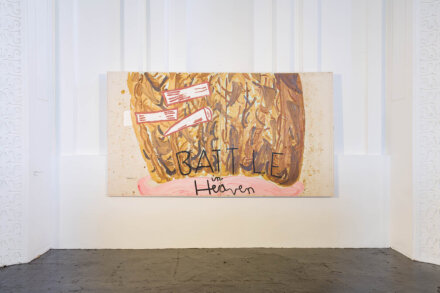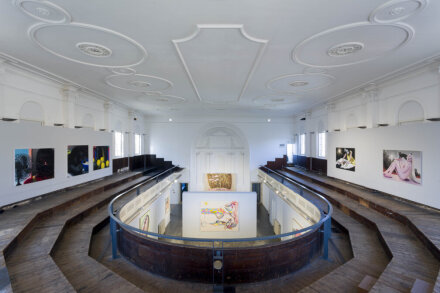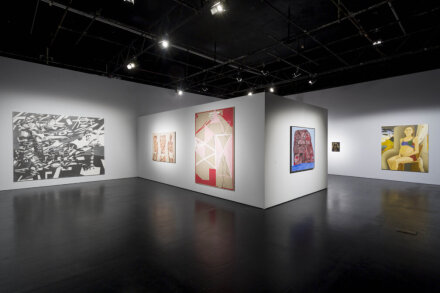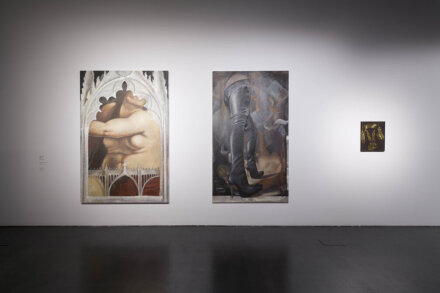
Rose Wylie, Battle in Heaven (Film Notes) (2008), via Zabludowicz Collection
Currently on view this month at the Zabludowicz Collection, a selection of the institution’s holdings are presented as a look at the progression and evolution of figuration in modern practice. The Stand-Ins brings together 19 artists who deploy autobiographical elements and a cast of imagined characters in the construction of their paintings and narratives, and maps lines of influence across generations, featuring seminal figures alongside important new voices.

The Stand-Ins: Figurative Painting from the Collection (Installation View), via Zabludowicz Collection
The show’s title implies something of the abstracted body, suggesting a temporary replacement, an understudy or avatar filling in for an absent lead. Placing this framework into a discussion on the fragility of bodies, the show makes much of the notion of the body as both deconstructed and reconstructed in repetitive movements, the act of depiction as an act of reconstruction and new understanding, particularly in the context of the pandemic. This air of uncertainty about interactions in the world we share cannot help but permeate artists’ studios today, but this concern has a long history that predates the contemporary moment.

The Stand-Ins: Figurative Painting from the Collection (Installation View), via Zabludowicz Collection
The exhibition recognizes the diversity of approaches found in figurative painting today, from work that overtly quotes art historical styles to work that is more closely linked to observation and realism, and work that moves towards abstraction. Rather than simply depicting exterior appearances, the artists brought together here map interior psychological spaces. Their work shows the sheer exuberance, imagination and humor with which artists continue to reimagine themselves and others via paint. Formal experimentation in composition and the use of materials often leads to the deconstruction of the body into parts: hollow vessels, mask-like layers and bundles of gestures. Sabotaging the idea of a singular self or fixed identity, this group of paintings looks at bodies from the inside out.

The Stand-Ins: Figurative Painting from the Collection (Installation View), via Zabludowicz Collection
A prevalent feature of the dialogue around painting today is the acknowledgement of influences from the past and the need for tenacity and longevity in art practice. Here the distinctive approaches of three landmark figures – Dorothea Tanning, Philip Guston and Maria Lassnig – provide a framework for the exhibition. Tanning was a pioneering artist associated with surrealism who developed her own realm of domestic disquiet and dream-like myth. Guston used humor and awkwardness to point directly at the injustices and absurdities he saw around him, and to explore how paintings could be self-contained but could also tell stories, famously taking a bold step away from abstraction to a cartoon-like figuration to do so. And in an approach she termed ‘body awareness’, Lassnig placed herself at the centre of an unflinching take on how flesh and mind intertwine, shift and sometimes come apart.

The Stand-Ins: Figurative Painting from the Collection (Installation View), via Zabludowicz Collection
The ability to remain responsive and reflexive in one’s painting practice is evident in work by many of the artists in the exhibition. Some have had long, rich careers; others are right at the beginning. Many look to, or indeed work in, different mediums, such as moving image, sculpture or music, alongside their painting practice. But painting for all these artists is a point of departure as well as arrival, acting as an enduring frame of reference as well as a history to be kicked against. The representation of the human body in art is not going away and, right now, expressing this as a painted image feels resolutely urgent.
The show closes February 13th.
– C. Reinhardt
Read more:
“The Stand-Ins” at Zabludowicz Collection [Exhibition Site]



